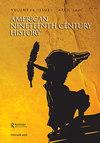Beyond antislavery and proslavery: a new term, eventualism, and a refined interpretive approach
IF 0.1
2区 历史学
Q3 HISTORY
引用次数: 0
Abstract
ABSTRACT For decades, historians of slavery have grappled with an interpretive constraint. Despite a conviction that the past is as complex as the present, we have operated, to a significant degree, on the simplifying premise that historical attitudes toward enslavement were either antislavery or proslavery—in modified form, immediatist/gradualist or perpetualist. These binary frames have undermined our efforts to write about, and in some ways to discern, attitudes that fell in the ambivalent middle. Through a case study of Henry Clay, one of the most influential politicians operating in this middle range, this article argues for the adoption of a new term, eventualism, that describes one of the most common expressions of ambivalence: declaring opposition to slavery while insisting that, for the sake of the Union, it be left alone and allowed to follow a natural course to extinction. By illustrating the benefits of a refined interpretive approach, immediatism-gradualism-eventualism-perpetualism, along with the benefits of certain interpretive principles that, if more widely adopted, will clarify and enhance inter-scholarly engagements, this article seeks to encourage and enable historians to continue the important work of explicating how and why many Americans, predominantly white Americans, espoused attitudes with significant internal tensions.超越反奴隶制和反奴隶制:一个新术语,事件论和一种精细的解释方法
摘要几十年来,奴隶制历史学家一直在与一种解释性约束作斗争。尽管我们坚信过去和现在一样复杂,但我们在很大程度上是在一个简化的前提下运作的,即对奴役的历史态度要么是反奴隶制的,要么是反奴役的——以改良的形式,直接主义/渐进主义或永久主义。这些二元框架破坏了我们写东西的努力,也在某种程度上破坏了我们辨别处于矛盾中间的态度的努力。通过对亨利·克莱(Henry Clay)的案例研究,本文主张采用一个新的术语,即偶然主义,该术语描述了矛盾心理最常见的表达方式之一:宣布反对奴隶制,同时坚持为了联邦,让它独处,任其走自然的灭亡之路。通过说明精细解释方法的好处,即直接主义、渐进主义、偶然主义、永恒主义,以及某些解释原则的好处,如果这些解释原则被更广泛地采用,将澄清和加强学术间的互动,本文试图鼓励并使历史学家能够继续进行重要的工作,以白人为主的美国民众支持内部紧张的态度。
本文章由计算机程序翻译,如有差异,请以英文原文为准。
求助全文
约1分钟内获得全文
求助全文

 求助内容:
求助内容: 应助结果提醒方式:
应助结果提醒方式:


